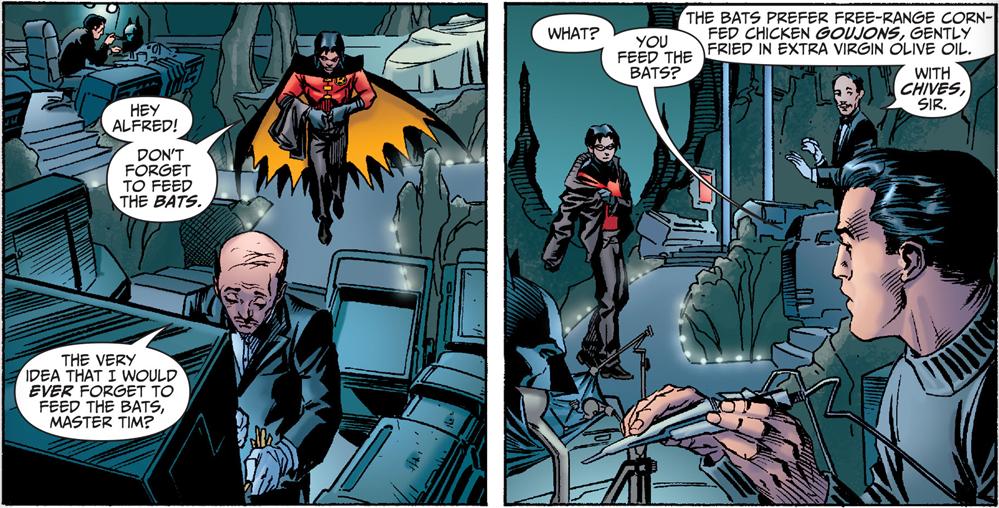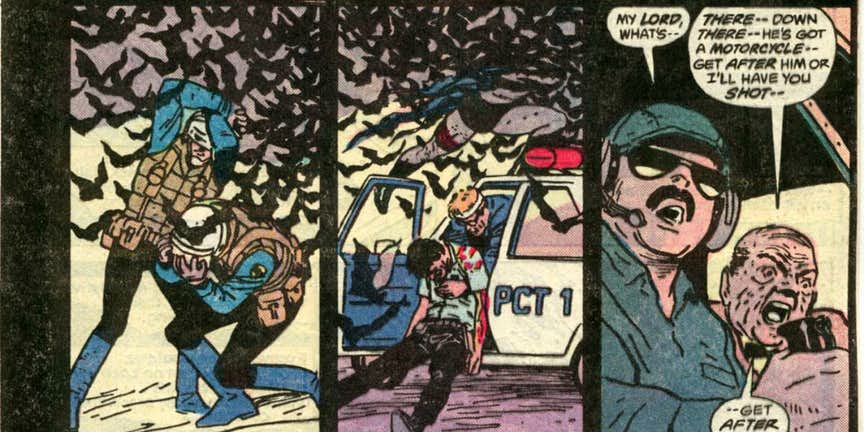Think about kids in a dangerous cave – the Thai soccer team, right? What about Batman?
He has kids in his cave all the time.
No one is going to argue that Batman’s Batcave has bats in it, either. How many is the question, as we’ve seen numbers ranging from a few here and there to jillions when needed, say, to attack a SWAT team in Batman: Year One or Batman Begins.
But news of the hospital observation for the 12 boys and their coach after being rescued from the cave in Thailand does bring home the point that sometimes, caves aren’t the safest places in the world, health-wise. The can often harbor microorganisms such as pathogenic bacteria and fungi, as well bats and other animals that can carry diseases that affect humans.
Maybe you’re like me, and maybe – just maybe, the drama and concern over the health of the Thai football team made you wonder about that other guy who occasionally has kids in a cave: Batman.
Some Batcave Background
As Brian Cronin explained at CBR.com, the Batcave first appeared in 1941 as a simple hangar for the Bat-plane and garage/shop for the Batmobile before being turned into a full-on Bat’s Cave in the black and white Batman movie serial – complete with bats. From there, the idea of a full-on cave was adapted to comics and modified many times over the decades. Comics continue to be where the cave is designed and modified, with the current version being a mix of ultra-modern super-science base with primitive, undeveloped recesses, accessible via Wayne Mansion above, or a maze of smaller passageways below, including a large underground river.
The Batcave has appeared in every media adaptation of Batman since, and has become a fixture in worldwide popular culture. And virtually everything has happened in the Batcave – fights, sieges, meetings, uh…adult romances, open wounds, surgery and…in at least one reality, a baby has been born there.
Batman’s hideout gets changed and modified by virtually every creative team that works on any version of Batman, so keeping up with an accurate depiction of it is pretty tough. Something things, the giant penny, the dinosaur, the computer and the cases of costumes seem to be pretty permanent, but everything else – including never-before-revealed rooms and prisons? Sure, if the story calls for it, why not?
But how safe is the cave? After all, those kids in Thailand were observed for a week after their stay, and there are stories about bats and carrying diseases like nobody’s business. If you had a young ward (or illegitimate son or adopted son, or fiance or…whoever) would you want them spending lots of time in a cave with bats and other stuff?
Let’s dig into some of the natural science of the Batcave.
Cave Dangers
Starting with the Thai football team – the concerns about their health are real, and well-founded. The caves the teammates and their coach explored – and in which they were trapped – were wet and reportedly teeming with life – from birds to bats to rats and all kind of insects and other arthropods like ticks, millipedes, scorpions and spiders.
No large animals though – that wasn’t a concern. Larger animals would have stayed clear of the deeper caves into which the boys ventured. Not enough light and not nearly enough promise of food. The problem for the boys was small – microscopically small in most cases. Chief among the possible infections in warm, humid caves is the fungus histoplasmosis – also called “cave disease” or “spelunker’s lung.” If histoplasmosis stays in the lungs and is treated early, it often responds very well to treatment. But if it gets into the bloodstream…that’s just bad news, and can be fatal if untreated.
Along with pathogens, microbes and fungi in the soil and bat guano, bats themselves can carry a large variety of viruses that can affect humans such as rabies. In Africa and other tropical locations, bats have been implicated in the spread of Marburg and Ebola, among other diseases – some of which we’re just learning about for the first time.
The bats themselves don’t get sick from the diseases they carry though – research suggests that the bats that carry such diseases have something…different going on with their immune systems, and that stops any infection in the bats before it can even get a start.
Additionally, if you’ve got a lot of bats in a cave, you’ve got a lot of guano and urine. As a result, in drier caves, ammonia levels in the cave can reach high enough concentrations to cause irritation and trouble breathing.
What About the Batcave?
While DC doesn’t like to make too many approximations of Gotham City’s location that’s analogous to the United States, you can safely put it in the mid-Atlantic region, somewhere in the New York City region (although Metropolis is often compared to NYC). Without knowing or assuming anything else about the Batcave, you can knock out the idea that the Bat-Family is putting themselves at risk for Ebola or Marburg. While bats do carry those diseases, they are carried by bats in tropical or equatorial regions, not temperate.
To get into a little more detail about the cave itself – the following comes from the official novelization of The Dark Knight Rises:
“The vast caverns had once been used to shelter runaway slaves escaping to the North. Damp limestone walls glistened beneath the subdued interior lighting that Bruce had installed years ago. A shallow, slow-moving river was all that remained of the underground waterway that had carved out the caverns in ages past. Massive wooden arches, high overhead, helped to support the mansion’s foundations.”
And that all works nicely – limestone caves are very common, and often, very long. Limestone caves are formed when rainwater with dissolved carbon dioxide in it forms a weak carbonic acid solution. Over hundreds or thousands of years, the weak carbonic acid dissolves the calcite in the limestone, leaving tunnels and chambers via the following reaction:
H2CO3 + 2CaCO3 -> Ca(HCO3)2
Carbonic acid plus calcite yields calcium bicarbonate
Calcium bicarbonate is soluble in water, so it just washes away.
In many limestone caves, and the Batcave appears to be no exception, the water source may change volume over the years, but continues “cutting” through the limestone until it can’t. As a result, the river that formed the cave system is often difficult to find or even absent from easily traveled pathways. With the water source leaving the cave behind in a sense, the cave can dry out and, in one particular case, be an okay location for a Batcomputer, a trophy room and a large array of vehicles – all without fear of water damage.
Also – without too much disturbance or air movement, caves will stay at the same temperature as the region’s annual temperature at the surface all year round. If we put the Batcave somewhere in the mid-Atlantic, that would be about mid-50s, Fahrenheit. Not horrible, but it explains why…
So the Batcave can be clean and dry and moderately comfortable when it comes to temperature. So far, so good.
What about the diseases?
Bats
Let’s just got for this one out of the gate – what are the bats in the Batcave?
If we step back into the fictional again, The Dark Knight Rises novelization identified the bats:
“Scores of North American brown bats roosted amidst the jagged stalactites hanging from the ceiling. Towering calcite columns rose hundreds of feet in height. The bats squeaked and rustled overhead.”
North American brown bats are also called little brown bats, and the name fits. The wingspan of a little brown bat rarely reaches 11 inches, and they’re usually around 2.5 – 4 inches long. It’s not the massive bat monster that smashed through the window and inspired the injured Bruce Wayne to become Batman. Not saying there aren’t other species of bats in the Batcave, but given its general location, the little brown bat would be the most prominent bat in there.
Other types of bats that could call the Batcave their home would include the big brown bat (probably what smashed through the window…and it was probably rabid to make such a dumb mistake), the small footed bat, the Indiana bat, the Northern long-eared bat and the Eastern pipistrelle bat.
All of the bats eat insects (sorry, Alfred) almost exclusively, and are therefore important to their ecosystem in keeping the pest population under control, especially in areas with lots of agriculture. Snakes and birds, among other predators eat them, so…if you’ve got a lot of bats in your cave, you’ve probably got something hunting the bats…at least on a day-trip basis, at least. And like most wild bat populations, little brown bats have a very low incidence of carrying rabies (a trait that’s been exaggerated in fiction and by the media) – even though it was noted in Batman #406 that bystanders to Batman’s bat-aided escape from the Gotham Police needed to get rabies vaccinations. It was probably Gotham medical officials erring on the side of caution.
And as for bats getting all caught up in the Bat-Holiday tree, nearly all of the bats will be hibernating during the winter. At other times, the light, noise and activity of the Batcave would probably keep the bats out of the larger rooms.
So if you ever find yourself in the Batcave, the bats will leave you alone as long as you leave them alone, with very little chance of the direct transmission of disease. So – not many threats to Batman and his family’s heath coming from the bats.
That’s the good news.
The bad?
You can make a safe bet that there are not as many bats in the Batcave now as there were when Batman started his fight against crime.
Chief among the threats the bats would be facing is White Nose Syndrome, a fungus that has literally wiped out populations of little brown bats and long-eared bats in many North American locations. The fungus is native to Europe (where bats seem to be immune), but has been introduced to North American bat populations via unknown means. WNS is a winter-blooming fungus and can be seen on the muzzles of infected bats during the cold months when they are hibernating. The fungal growth eats into the wing edges of the bats and irritates them to the point they wake up during hibernation. With no food available, they quickly starve to death.
When it first started appearing in bat colonies around 2006, scientists gave dire predictions of 90-100% of bat populations being wiped out. Since then, UV-light and bacteria-based treatments have been developed, and some populations are showing resistance to the fungus. But it will take years for the affected bat populations to recover.
And of course, bats in North America are under other, environmental stressors, resulting in a decline of bat populations across the continent.
You know, just a quick shot of proof of the Wayne Foundation funding WNS research of bat conservation in an issue of Batman or Detective Comics would be pretty cool.
Other Stuff in that Cave
As long as the bats stay away from you, and you stay away from the bats in the Batcave, you should be okay. Play in the bat habitats in the cave (I like to think Batman cordons off portions of the Batcave just for the bats…), and you’re back to risking infection from a variety of agents – histoplasmosis, parasites (ticks, bedbugs, fleas), and other bacteria that’s present in the guano on the floor of the cave, and thick in the air as the bats are flying and…well, bats don’t have bathrooms. Also, some bat-scientists do think that the hypersonic sounds bats give off to navigate could work to aerosolize their urine and saliva as they fly, making it perfect for inhalation. Just stay away from the bats.
Otherwise, the Batcave is probably a pretty safe environment. Smaller arthropods wouldn’t find much food, and it would be pretty chilly for them, so they probably won’t hang out just waiting to sting a Robin that happens by. And as for bacteria and fungus that could do a Bat-Family member harm, caving expert and microbiologist Hazel Barton explains that some dry cave environments have lower cell counts than you would find in Antarctica. That’s pretty clean.
But of course, everyone knows why we’re not going to see a Batman-Family: Marburg event storyline. The cleanliness of the Batcave isn’t some lucky coincidence of nature or special conditions.
And as has been said in a few of DC’s guides to the Batcave, Alfred is constantly cleaning.


















